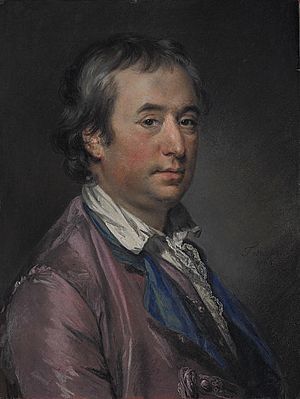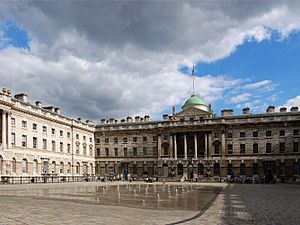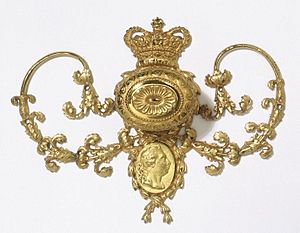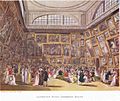William Chambers (architect) facts for kids
Quick facts for kids
Sir William Chambers
|
|
|---|---|

William Chambers, painted in 1764 by Frances Cotes
|
|
| Born | 23 February 1723 Gothenburg, Sweden
|
| Died | 10 March 1796 (aged 73) London, England
|
| Nationality | British (originally Scottish) |
| Occupation | Architect |
| Buildings | Casino at Marino Dundas House (now the headquarters of the Royal Bank of Scotland) Dunmore Pineapple Somerset House |
Sir William Chambers RA (born February 23, 1723 – died March 10, 1796) was an important architect from Sweden and Scotland. He lived and worked mostly in London, England. He is famous for designing Somerset House and the Great Pagoda at Kew Gardens. Chambers also helped start the Royal Academy, a famous art and architecture group.
Life and Early Adventures
From Sweden to China
William Chambers was born in Gothenburg, Sweden, on February 23, 1723. His father was a Scottish merchant, which means he bought and sold goods.
When he was young, from 1740 to 1749, William worked for the Swedish East India Company. This company traded with countries in Asia. He traveled to China three times during this period. While in China, he learned a lot about Chinese architecture and how they decorated buildings.
Becoming an Architect
After his travels, William came back to Europe. He studied architecture in Paris, France, and then spent five years learning in Italy. In 1755, he moved to London and started his own architecture business.
In 1757, he got a special job: teaching architecture to the Prince of Wales, who later became King George III. He also worked for the Princess Augusta, who was the King's mother. For her, he designed fun and imaginative buildings for the gardens at Kew.
Sharing New Ideas
In 1757, Chambers published a book about Chinese designs. This book was very popular and influenced how people decorated their homes and gardens in England. He later wrote another book, Dissertation on Oriental Gardening (1772), which talked more about the natural style of Chinese gardens.

Chambers also wrote a serious book called Treatise on Civil Architecture in 1759. This book was very helpful for other builders and architects. It explained how to use classical styles in buildings and gave ideas for decorations. This book was reprinted many times, even up to 1862! It shared ideas from Italian architects that were not well known in Britain at the time. Many younger architects learned from Chambers by working in his office, including Thomas Hardwick, who helped him build Somerset House.
Rivalry and Influence
Chambers was a main competitor to another famous architect, Robert Adam, in the style called Neoclassicism in Britain. Neoclassicism was a style that used ideas from ancient Greek and Roman buildings. Chambers had a more international view because he had traveled a lot. He was influenced by European Neoclassicism and also influenced it himself.
From about 1758 to the mid-1770s, Chambers mostly designed houses for rich and important families. In 1766, he became a foreign member of the Royal Swedish Academy of Sciences. He also held important official jobs for the King, eventually becoming the Surveyor-General and Comptroller of the King's Works in 1782, a top position in charge of royal buildings.
Somerset House and the Royal Academy
One of his biggest projects was Somerset House in London. This huge building was planned to bring many government offices together. Chambers became the architect for this project in 1775. He spent many years working on it, from 1776 until his death in 1796.
Chambers also played a very important role in starting the Royal Academy in 1768. He told the King that many artists wanted to create a society to promote art and design. He was chosen as the Academy's first Treasurer.
His Final Resting Place
Sir William Chambers passed away in London in 1796. He is buried in Poets' Corner in Westminster Abbey, a very famous church where many important people are laid to rest. His tombstone says:
Sir William Chambers, Knight of the Polar Star, Architect, Surveyor General of His Majesty's Works, F.R.S., F.A.S., R.S. Died March 8th, 1796. Aged 74.
Main Works and Designs
Sir William Chambers designed many famous buildings and structures. Here are some of his most notable works:
- Roehampton Villa: A large house for Lord Bessborough, much of which still exists today. He also designed two garden temples for this estate.
- Buildings at Kew Gardens: While some of his buildings at Kew are gone, you can still see the amazing ten-story Great Pagoda, the Orangery, the Ruined Arch, the Temple of Bellona, and the Temple of Aeolus.
- The Pagoda in Blackheath, London: This three-story house, built around 1775, has a unique Chinese-style roof with upturned corners.
- Somerset House: This is his most famous building in London. It took him over two decades to build and is a grand example of his work.
- The gilded state coach: This beautiful, golden carriage is still used for important events like coronations of British monarchs.
- Hedsor House: A house in Buckinghamshire for Lord Boston.
- Works in Ireland: For Lord Charlemont, he designed Charlemont House and the unique Casino at Marino. He also designed the chapel and a public theatre at Trinity College, Dublin.
- Milton Abbey and Milton Abbas: He helped add Gothic parts to Milton Abbey in Dorset and planned the nearby village of Milton Abbas. This village is sometimes called the first planned settlement in England.
- Wick House, Richmond Hill: A house commissioned by the famous painter Sir Joshua Reynolds.
Gallery of Architectural Works
Images for kids
See also
 In Spanish: William Chambers (arquitecto) para niños
In Spanish: William Chambers (arquitecto) para niños



























